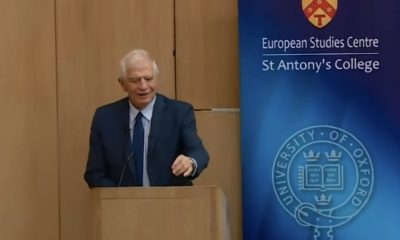EU
1,000th #ERC #ProofOfConceptGrant được trao

 The European Research Council just awarded top-up funding totalling €9.3 million to 62 ERC grant holders via its Proof of Concept scheme. The grants will help them explore the commercial or societal potential of their ERC-funded discoveries. This latest batch of grants includes the 1000th project to receive Proof of Concept funding since the scheme started in 2011. Engineer Miguel González Herráez, based in the University of Alcalá, will manage the milestone project.
The European Research Council just awarded top-up funding totalling €9.3 million to 62 ERC grant holders via its Proof of Concept scheme. The grants will help them explore the commercial or societal potential of their ERC-funded discoveries. This latest batch of grants includes the 1000th project to receive Proof of Concept funding since the scheme started in 2011. Engineer Miguel González Herráez, based in the University of Alcalá, will manage the milestone project.Among the greatest challenges in seismology is the sparsity of instrumentation across Earth’s oceans, which cover 70% of its surface. Modern seismological instruments, that help anticipate earthquakes and mitigate some of the disastrous consequences of tsunamis, are not well adapted to monitor underwater areas (they are generally very expensive and have a short lifetime). Prof González Herráez’s project aims to provide a low-cost, permanent solution for sensing seismic activity in remote areas of the ocean. His intention is to create a method to retrofit the extensive existing networks of underwater telecommunication fiber optic cables, and transform them into powerful seismic sensing arrays.
Research, Science and Innovation Commissioner Carlos Moedas said: “Europe excels in turning money into great science, but still has to improve its ability to turn excellent science into money and benefits to society. For the past eight years, ERC Proof of Concept grants have helped top researchers progress in the world of entrepreneurship. I believe the new European Innovation Council will also be able to assist them in their endeavors.”
ERC President Professor Jean-Pierre Bourguignon said: “This milestone shows once again that many researchers spontaneously link frontier research and innovation. ERC-funded research is a long-term investment that lays the foundations for the industries and services of the future. The Proof of Concept scheme helps ERC grantees take their discoveries a step closer to market or societal issues.”
1,000 PoC projects funded
Proof of Concept (PoC) grants, worth €150,000 each, aim to help researchers explore the commercial or societal potential of their work. They can be used in various ways, for example to explore business opportunities, prepare patent applications or verify the practical viability of scientific concepts.
Prof González Herráez’s new project builds on the findings of his previous ERC funded research, which developed a new class of sensor arrays using conventional fibre-optic cables. The sensors can be used in a wide range of new domains, from biomechanics to smart grids. Having currently narrowed in on the field of seismology, he and his team will use a single optoelectronic unit in the onshore end of the fibre optic cable, to monitor a full span of 50 km or more, and generate information from thousands of measuring points. The proposed solution could easily allow the deployment of a large number of such sensor arrays, particularly in currently unmonitored areas. Another big advantage would be that the vast majority of fibre-optic cables used worldwide for communications are suitable hosts for the proposed sensor. The system will be first tested in an underwater cable off the coast of Greece (at Pylos, Peloponnese).
The other 61 awarded projects in this funding round cover a variety of topics: including a process to enable personalised doses of medication, an app to test children for synaesthesia (e.g. when a person sees a number as a particular colour), and a tool to automatically remove bugs from hardware dataplanes (the infrastructure of a network that carries its traffic). See more ví dụ về các dự án được tài trợ.
The new grants were awarded to researchers working in 15 countries: Austria (1 grant), Belgium (3), Denmark (2), Finland (2), France (6), Germany (4), Greece (2), Ireland (2), Israel (3), Italy (9), Netherlands (8), Romania (1), Spain (4), Switzerland (5) and the UK (10).
Proof of Concept (PoC) grants - what is new in 2019.
PoC grants were created by the ERC’s Scientific Council to complement the range of ERC core grants and other activities, which all form part of the EU's Research and Innovation programme, Horizon 2020. An independent xem xét shows the funding, available since 2011, has helped ERC-funded scientists attract capital to make their research marketable and set up new companies. The budget for the whole 2019 PoC competition - which takes place in three rounds - is €25 million. Today's announcement concerns the second funding round of 2019, in which the ERC evaluated 132 applications, slightly lower than the 134 evaluated during the vòng đầu tiên.
To further facilitate the transfer of knowledge gained from ERC funded research to the wider world the ERC recently launched a Virtual Venture Fair. It aims to help generate connections between ERC PoC funded scientists and specialised investors who can locate necessary finance and support.
For potential applicants
The PoC grant scheme is only open to ERC funded researchers. ERC grantees can apply for funding in one of the three rounds of the call every year. Eligible researchers who would like to compete for funding in 2019 have until 19 September 2019 to apply for the last round of funding. Visit our trang mạng for full application details.
Hội đồng Nghiên cứu châu Âu
Sản phẩm Hội đồng Nghiên cứu châu Âu, set up by the European Union in 2007, is the premiere European funding organization for excellent frontier research. Every year, it selects and funds the very best, creative researchers of any nationality and age, to run projects in Europe. The ERC also strives to attract top researchers from anywhere in the world to come to work in Europe. To date, the ERC has funded around 9,000 top researchers at various stages of their careers. It offers four core grant schemes: Starting, Consolidator, Advanced and Synergy Grants. The ERC is led by an independent governing body, the Scientific Council. The ERC President is Professor Jean-Pierre Bourguignon. The ERC has a budget of over €13 billion for the years 2014 to 2020, part of Horizon 2020, for which Research, Innovation and Science Commissioner Carlos Moedas is responsible.
Chia sẻ bài viết này:
-

 Common Ngoại giao và Chính sách An ninh5 ngày trước
Common Ngoại giao và Chính sách An ninh5 ngày trướcNgười đứng đầu chính sách đối ngoại của EU đưa ra quan điểm chung với Vương quốc Anh trong bối cảnh đối đầu toàn cầu
-

 Iran3 ngày trước
Iran3 ngày trướcTại sao lời kêu gọi của Nghị viện EU liệt IRGC vào danh sách tổ chức khủng bố vẫn chưa được giải quyết?
-

 Brexit3 ngày trước
Brexit3 ngày trướcCây cầu mới dành cho giới trẻ châu Âu ở hai bên eo biển Manche
-

 Kyrgyzstan4 ngày trước
Kyrgyzstan4 ngày trướcTác động của sự di cư hàng loạt của người Nga đối với căng thẳng sắc tộc ở Kyrgyzstan

























